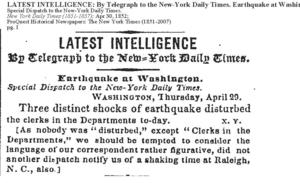Earthquakes

"Natural Philosophers, too generally I think in devoting their attention to their own closet experiments, overlook the often much more instructive and sublime experiments which Nature of herself is daily performing before their eyes." --Henry D. Rogers to Joseph Henry, June 15, 18431
COLLECTING DATA ABOUT EARTHQUAKES
The wide range of scientific interests and knowledge possessed by 19th-century American physicist Joseph Henry made him well suited to serve as the Smithsonian's first Secretary . In 1846, Henry was appointed to carry out the mission of this then fledgling institution, established with funds bequeathed to the United States by British scientist James Smithson "for the increase and diffusion of knowledge." Henry's first major scientific undertaking was to establish a network of observers throughout the United States for providing the Smithsonian with meteorological data.

In April 1850, Henry sent a list of "Observations in relation to Earthquakes,"3 developed for him by geologist John Lord Hayes, to astronomer James Melville Gilliss. As the leader of an expedition to South America, Gilliss had arrived in Santiago, Chile, several months earlier, and had already reported four earthquakes. A seismometer ordered by Henry from Scottish geologist James David Forbes, was in place for the last of the four, but failed to record any activity.4 In his letter to Gilliss,5 Henry suggested that "perhaps a pane of glass place[d] on the top of a post and strewed with sand" would indicate the direction of the minor tremors Gillis had been experiencing, and that the seismometer might work for larger earthquakes.
1852 EARTHQUAKE

Several days after an earthquake shook Washington, DC, in 1852, Henry developed his own list of questions for members of the Smithsonian’s network of weather observers living in range of the quake. A slightly expanded version of this circular was printed in 1855 . Henry believed the answers to these questions would help determine the geographical origin and intensity of earthquakes.
In response to the questions Henry distributed in 1852, Lewis F. Steiner of Frederick, Maryland, penned a letter describing the observations of a friend who experienced the earthquake. "Mr. F. regrets that he could not observe 'the attendant phenomena, with as much care as he desired in consequence of the great alarm of the ladies who were in the room with him.' He compares the vertical movement, 'to that produced by riding rapidly over a suspension or common wooden bridge where the string pieces are long, and the piers distant from each other;' and the horizontal, 'to that of a ship on the ocean.' The sound accompanying the shock, he compares to that 'heard over a rail-road tunnel during the passage of a train of cars through it.'"
In the Smithsonian's annual report, general assistant Edward Foreman reported that "numerous replies" were received in response to the 1852 earthquake circular, "embodying facts sufficient to enable the Institution to mark the point of chief intensity, and trace out the diverging lines along which the earth-wave passed."6
EARTHQUAKE SCIENCE

In 1869, Henry wrote to engineer Barton Alexander, stationed in California, to advise him on the construction of buildings that could withstand San Francisco’s earthquakes. Here Henry outlined the theory he shared with geologists of the time that earthquakes were the result of sudden breaks, uplifts, or depressions of the earth's crust. It was not until 1883 that geologist Grove Karl Gilbert argued earthquakes were caused by movement along faults.8 Henry's attempts to systematically track and study earthquakes in the United States provided a baseline of data for later scientists to consult in their own research.
FURTHER RESOURCES
"Ocean Portal: Earthquakes Resources," National Museum of Natural History, 2010.
Courtney Esposito, "All Shook Up: A History of Earthquakes at the Smithsonian," The Bigger Picture (blog), Smithsonian Institution Archives, September 21, 2011.
FOOTNOTES
1 Henry D. Rogers to Joseph Henry, 15 June 1843, in The Princeton Years: January 1841–December 1843, Nathan Reingold, Marc Rothenberg, Kathleen Dorman, and Paul H. Theerman, eds., vol. 5 of The Papers of Joseph Henry, (Washington, DC: Smithsonian Institution, 1985), 361. Return to text
2 Frank Millikan, "Joseph Henry: Father of the Weather Service," The Princeton Years: January 1841–December 1843, 24n. Return to text
3 Joseph Henry to James Gilliss, 10 April 1850, in Letters Received by the US Naval Astronomical Expedition to the Southern Hemisphere, Records of the Naval Observatory, RG 78, National Archives and Records Administration. Return to text
4 Marc Rothenberg and Kathleen Dorman, eds., The Smithsonian Years: January 1850–December 1853, vol. 8 of The Joseph Henry Papers (Washington, DC: Smithsonian Institution, 1998), 9–10n. Return to text
5 Joseph Henry to James Gilliss, 10 April 1850, Letters Received by the US Naval Astronomical Expedition to the Southern Hemisphere, Records of the Naval Observatory, RG 78, National Archives and Records Administration. Return to text
6Annual Report of the Board of Regents of the Smithsonian Institution for the Year 1852 (Washington, DC: US Government Printing Office, 1853), 74. Return to text
7 Joseph Henry to Barton Stone Alexander, 27 February, 1869, in The Smithsonian Years: January 1866–May 1878, Marc Rothenberg, Kathleen W. Dorman, and Frank R. Millikan, eds., vol. 11 of The Papers of Joseph Henry, (Washington, DC: Smithsonian Institution in association with Science History Publications/USA, 2007), 229. Return to text
8 Rothenberg, Dorman, and Millikan, The Smithsonian Years: January 1866–May 1878, 231n. Return to text
